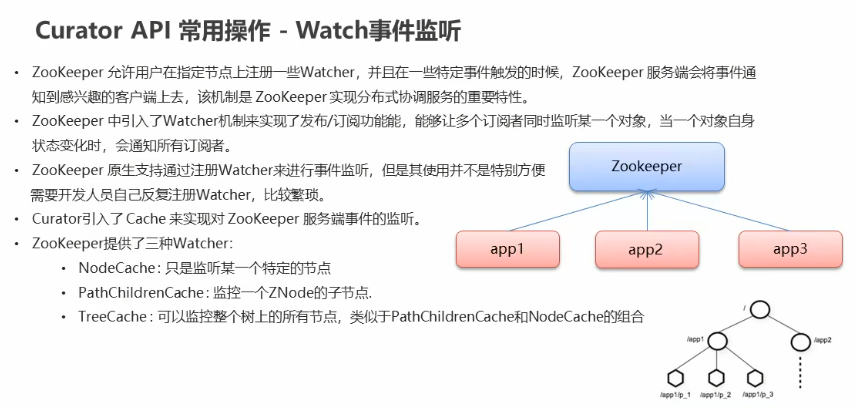【Zookeeper】Re02 CuratorAPI
Curator,提供给Java操作ZK的API组件:
需要的组件依赖:
<!-- https://mvnrepository.com/artifact/org.apache.curator/curator-framework -->
<dependency>
<groupId>org.apache.curator</groupId>
<artifactId>curator-framework</artifactId>
<version>5.2.0</version>
</dependency> <!-- https://mvnrepository.com/artifact/org.apache.curator/curator-recipes -->
<dependency>
<groupId>org.apache.curator</groupId>
<artifactId>curator-recipes</artifactId>
<version>5.2.0</version>
</dependency> <dependency>
<groupId>junit</groupId>
<artifactId>junit</artifactId>
<version>4.12</version>
<scope>test</scope>
</dependency> <!-- https://mvnrepository.com/artifact/org.slf4j/slf4j-api -->
<dependency>
<groupId>org.slf4j</groupId>
<artifactId>slf4j-api</artifactId>
<version>1.7.32</version>
</dependency> <!-- https://mvnrepository.com/artifact/org.slf4j/slf4j-log4j12 -->
<dependency>
<groupId>org.slf4j</groupId>
<artifactId>slf4j-log4j12</artifactId>
<version>1.7.32</version>
<scope>test</scope>
</dependency>
Curator要求配置日志组件,当然不配也是可以的
Log4J还要求配置log4j.properties,配置文件是随便找的
# priority :debug<info<warn<error
#you cannot specify every priority with different file for log4j
log4j.rootLogger=debug,stdout,info,debug,warn,error #console
log4j.appender.stdout=org.apache.log4j.ConsoleAppender
log4j.appender.stdout.layout=org.apache.log4j.PatternLayout
log4j.appender.stdout.layout.ConversionPattern= [%d{yyyy-MM-dd HH:mm:ss a}]:%p %l%m%n
#info log
log4j.logger.info=info
log4j.appender.info=org.apache.log4j.DailyRollingFileAppender
log4j.appender.info.DatePattern='_'yyyy-MM-dd'.log'
log4j.appender.info.File=./src/com/hp/log/info.log
log4j.appender.info.Append=true
log4j.appender.info.Threshold=INFO
log4j.appender.info.layout=org.apache.log4j.PatternLayout
log4j.appender.info.layout.ConversionPattern=%d{yyyy-MM-dd HH:mm:ss a} [Thread: %t][ Class:%c >> Method: %l ]%n%p:%m%n
#debug log
log4j.logger.debug=debug
log4j.appender.debug=org.apache.log4j.DailyRollingFileAppender
log4j.appender.debug.DatePattern='_'yyyy-MM-dd'.log'
log4j.appender.debug.File=./src/com/hp/log/debug.log
log4j.appender.debug.Append=true
log4j.appender.debug.Threshold=DEBUG
log4j.appender.debug.layout=org.apache.log4j.PatternLayout
log4j.appender.debug.layout.ConversionPattern=%d{yyyy-MM-dd HH:mm:ss a} [Thread: %t][ Class:%c >> Method: %l ]%n%p:%m%n
#warn log
log4j.logger.warn=warn
log4j.appender.warn=org.apache.log4j.DailyRollingFileAppender
log4j.appender.warn.DatePattern='_'yyyy-MM-dd'.log'
log4j.appender.warn.File=./src/com/hp/log/warn.log
log4j.appender.warn.Append=true
log4j.appender.warn.Threshold=WARN
log4j.appender.warn.layout=org.apache.log4j.PatternLayout
log4j.appender.warn.layout.ConversionPattern=%d{yyyy-MM-dd HH:mm:ss a} [Thread: %t][ Class:%c >> Method: %l ]%n%p:%m%n
#error
log4j.logger.error=error
log4j.appender.error = org.apache.log4j.DailyRollingFileAppender
log4j.appender.error.DatePattern='_'yyyy-MM-dd'.log'
log4j.appender.error.File = ./src/com/hp/log/error.log
log4j.appender.error.Append = true
log4j.appender.error.Threshold = ERROR
log4j.appender.error.layout = org.apache.log4j.PatternLayout
log4j.appender.error.layout.ConversionPattern = %d{yyyy-MM-dd HH:mm:ss a} [Thread: %t][ Class:%c >> Method: %l ]%n%p:%m%n
API操作:
创建连接:
第一种,根据构造参数创建客户端对象
第二种,使用构建工厂管理创建客户端对象
/**
* 创建节点一
*
*/
@Test
public void establishConnection1() {
/**
* 方式一
* String connectString,
* 单例参数 "192.168.242.101:2181"
* 集群参数 "192.168.242.101:2181, 192.168.242.102:2181, 192.168.242.103:2181"
* int sessionTimeoutMs,
* 回话超时限制
* int connectionTimeoutMs,
* 连接超时限制
* RetryPolicy retryPolicy, ZKClientConfig zkClientConfig
* 重新连接策略
*
*/
ExponentialBackoffRetry exponentialBackoffRetry = new ExponentialBackoffRetry(3000, 10);// 3秒 10次 CuratorFramework curatorFramework = CuratorFrameworkFactory.newClient(
"192.168.242.101:2181",
1000 * 60, // 1分钟
1000 * 15, // 15秒
exponentialBackoffRetry
); curatorFramework.start(); // 建立连接
} /**
* 创建节点二
*
*
*/
@Test
public void establishConnection2() {
CuratorFramework curatorFramework = CuratorFrameworkFactory
.builder()
.sessionTimeoutMs(1000 * 60)
.connectionTimeoutMs(1000 * 15)
.connectString("192.168.242.101:2181")
.retryPolicy(new ExponentialBackoffRetry(3000, 10))
.namespace("nmNode") // 指定在一个节点下进行操作
.build(); curatorFramework.start();
}
为便于操作Zookeeper,使用Junit的前置调用和后置调用注解:
创建资源和释放资源
CuratorFramework zookeeperClient;
@Before
public void prepareConnection() {
zookeeperClient = CuratorFrameworkFactory
.builder()
.sessionTimeoutMs(1000 * 60)
.connectionTimeoutMs(1000 * 15)
.connectString("192.168.242.101:2181")
.retryPolicy(new ExponentialBackoffRetry(3000, 10))
.namespace("nmNode") // 指定在一个节点下进行操作
.build(); zookeeperClient.start();
} @After
public void afterSettleConnection() {
if (zookeeperClient != null) zookeeperClient.close();
}
创建ZK节点:
/**
* 创建节点操作
*
*/
@Test
public void createNodeAPI() {
String forPath = null;
try {
// 纯创建节点
forPath = zookeeperClient.create().forPath("/node1");
System.out.println(forPath); // 创建带数据的节点
forPath = zookeeperClient.create().forPath("/node2", "node with data".getBytes(StandardCharsets.UTF_8));
System.out.println(forPath);
/**
* 指定模式
* CreateMode
* PERSISTENT(0, false, false, false, false),
* PERSISTENT_SEQUENTIAL 持久化顺序模式
* EPHEMERAL 临时模式
* EPHEMERAL_SEQUENTIAL 临时顺序模式
* CONTAINER 容器模式
* PERSISTENT_WITH_TTL 持久化超时模式
* PERSISTENT_SEQUENTIAL_WITH_TTL 持久化顺序超时模式
*/
forPath = zookeeperClient
.create()
.withMode(CreateMode.PERSISTENT)
.forPath("/node2", "node with data".getBytes(StandardCharsets.UTF_8));
System.out.println(forPath); /**
* 创建多级节点
* .creatingParentsIfNeeded()
*/
forPath = zookeeperClient
.create()
.creatingParentsIfNeeded()
.withMode(CreateMode.PERSISTENT)
.forPath("/node2/subNode1/subSubNode1", "node with data2".getBytes(StandardCharsets.UTF_8));
System.out.println(forPath);
} catch (Exception exception) {
exception.printStackTrace();
}
}
查询ZK节点:
/**
* 查询节点
*/
@Test
public void queryNodes() {
byte[] data = null;
try {
// 获取该节点下的数据
data = zookeeperClient.getData().forPath("/node2");
System.out.println(new String(data, StandardCharsets.UTF_8)); /**
* 获取该节点下的子节点
*
* 注意使用/根节点表示时,namespace("nmNode")的影响
* zookeeperClient.getChildren().forPath("/")
*/
List<String> strings = zookeeperClient.getChildren().forPath("/node1");
System.out.println(strings); /**
* ls -s 节点
* 查询节点状态
*
* stat空参数表示 0 0 0 0 0 初始状态
*/
Stat stat = new Stat(); // 携带构造后会进行赋值操作
zookeeperClient.getData().storingStatIn(stat).forPath("/node2");
System.out.println(stat); // 52,52,1635080231927,1635080231927,0,4,0,0,14,4,73 } catch (Exception e) {
e.printStackTrace();
}
}
修改节点:
/**
* 修改节点
*/
@Test
public void updateNode() {
try {
/**
* 简单修改节点值
*/
Stat stat = zookeeperClient.setData().forPath("/node1/subNode1", "changes Data".getBytes(StandardCharsets.UTF_8)); /**
* 乐观锁控制
* getVersion
*/
String subNode2 = "/node1/subNode1";
Stat subStat = new Stat();
zookeeperClient.getData().storingStatIn(subStat);
zookeeperClient.setData().withVersion(subStat.getVersion()).forPath(subNode2, "changes Data2".getBytes(StandardCharsets.UTF_8)); } catch (Exception exception) {
exception.printStackTrace();
}
}
删除ZK节点
/**
* 删除节点
*
*
*/
@Test
public void deleteNode() { try { /**
* 普通删除 /node1/subNode1
*
* 该节点带有子节点则报错,不能被删除
* KeeperErrorCode = Directory not empty for /nmNode/node1
* */
// Void unused = zookeeperClient.delete().forPath("/node1"); /**
* 带节点全部删除
*
*/
// zookeeperClient.delete().deletingChildrenIfNeeded().forPath("/node2"); // 带保证的删除? 防止网络抖动断开连接,会调用重试删除
zookeeperClient.delete().guaranteed().forPath("delete success"); // 删除成功的回调处理
zookeeperClient.delete().guaranteed().inBackground(new BackgroundCallback() {
// 操作成功时将执行回调
@Override
public void processResult(CuratorFramework client, CuratorEvent event) throws Exception {
System.out.println("delete success"); }
}).forPath("/node1"); } catch (Exception exception) {
exception.printStackTrace();
} }

监听节点:
@Test
@SuppressWarnings("deprecation")
public void listeningFeature() { // nodeCache 被标注为已过时方法
NodeCache nodeCache = new NodeCache(zookeeperClient, "/node1"); // Listenable<使用这个泛型只能声明一种监听类型> listenable = nodeCache.getListenable();
Listenable listenable = nodeCache.getListenable(); // 绑定监听事件
listenable.addListener(new NodeCacheListener() {
@Override
public void nodeChanged() throws Exception {
String path = nodeCache.getPath();
System.out.println("this node changed: " + path); // 获取变化后的数据
byte[] data = nodeCache.getCurrentData().getData();
System.out.println("after change, data is " + new String(data, StandardCharsets.UTF_8));
}
}); // 绑定子节点监听事件
listenable.addListener(new PathChildrenCacheListener() { @Override
public void childEvent(CuratorFramework client, PathChildrenCacheEvent pathChildrenCacheEvent) throws Exception {
System.out.println("subNode changed, event -> " + pathChildrenCacheEvent); // 获取子节点事件类型
PathChildrenCacheEvent.Type type = pathChildrenCacheEvent.getType(); // 如果是修改事件触发,则开始执行XXX。。。
if (PathChildrenCacheEvent.Type.CHILD_UPDATED .equals(type)) {
byte[] data = pathChildrenCacheEvent.getData().getData();
System.out.println("new Data -> " + new String(data, StandardCharsets.UTF_8));
}
}
}); // 绑定树节点监听事件 一般直接监听当前命名空间的全部节点
TreeCache treeCache = new TreeCache(zookeeperClient, "/");
Listenable<TreeCacheListener> listenable1 = treeCache.getListenable();
listenable1.addListener(new TreeCacheListener() {
@Override
public void childEvent(CuratorFramework curatorFramework, TreeCacheEvent treeCacheEvent) throws Exception {
System.out.println("changed");
System.out.println(treeCacheEvent);
}
});
}
【Zookeeper】Re02 CuratorAPI的更多相关文章
- 【Zookeeper】源码分析目录
Zookeeper源码分析目录如下 1. [Zookeeper]源码分析之序列化 2. [Zookeeper]源码分析之持久化(一)之FileTxnLog 3. [Zookeeper]源码分析之持久化 ...
- 【Zookeeper】基础学习概览【汇总】
一.概述 1.1 简介 1.2 Zookeeper集群机制 1.3 Zookeeper特性 二.Zookeeper应用场景 三.Zookeeper数据结构 四.Zookeeper安装 五.Java操作 ...
- 【Zookeeper】 在Java中的操作
一.基本功能演示 1.1 Maven依赖信息 1.2 代码演示 方法说明 1.3 创建Zookeeper节点信息 二.Watcher 2.1 什么是Watcher接口 2.2 Watcher代码 一. ...
- 【Zookeeper】编程实战之Zookeeper分布式锁实现秒杀
1. Zookeeper简述 我们要了解一样技术,首先应该要到它的官网,因为官网的信息一般都是最准确的,如下图是Zookeeper官网对它的介绍. 从官网的介绍中,可以总结出,Zookeeper是一个 ...
- 【Zookeeper】源码之序列化
一.前言 在完成了前面的理论学习后,现在可以从源码角度来解析Zookeeper的细节,首先笔者想从序列化入手,因为在网络通信.数据存储中都用到了序列化,下面开始分析. 二.序列化 序列化主要在zook ...
- 【Zookeeper】源码分析之持久化--FileTxnLog
一.前言 前一篇已经分析了序列化,这篇接着分析Zookeeper的持久化过程源码,持久化对于数据的存储至关重要,下面进行详细分析. 二.持久化总体框架 持久化的类主要在包org.apache.zook ...
- 【Zookeeper】源码分析之持久化--FileTxnSnapLog
一.前言 前面分析了FileSnap,接着继续分析FileTxnSnapLog源码,其封装了TxnLog和SnapShot,其在持久化过程中是一个帮助类. 二.FileTxnSnapLog源码分析 2 ...
- 【Zookeeper】源码分析之Watcher机制(一)
一.前言 前面已经分析了Zookeeper持久话相关的类,下面接着分析Zookeeper中的Watcher机制所涉及到的类. 二.总体框图 对于Watcher机制而言,主要涉及的类主要如下. 说明: ...
- 【Zookeeper】源码分析之Watcher机制(二)
一.前言 前面已经分析了Watcher机制中的第一部分,即在org.apache.zookeeper下的相关类,接着来分析org.apache.zookeeper.server下的WatchManag ...
- 【Zookeeper】源码分析之Watcher机制(三)之Zookeeper
一.前言 前面已经分析了Watcher机制中的大多数类,本篇对于ZKWatchManager的外部类Zookeeper进行分析. 二.Zookeeper源码分析 2.1 类的内部类 Zookeeper ...
随机推荐
- python-使用百度AipOcr实现表格文字图片识别
注:本博客中的代码实现来自百度问答:https://jingyan.baidu.com/article/c1a3101ef9131c9e646deb5c.html 代码运行环境:win10 pyth ...
- Dva.js 快速上手指南
先说些废话 最近在开发React技术栈的项目产品,对于数据状态的管理使用了Dva.js,作为一个资深的ow玩家,我看到这个名字第一反应就是----这不是ow里的一个女英雄吗?仔细阅读了官方文档之后,发 ...
- List<Map<String, Object>> 按照时间排序
// 准备一个集合 List<Map<String, Object>> resList= Lists.newArrayList(); Map<String, Object ...
- Java中的ThreadLocal和 InheritableThreadLocal
Java中的ThreadLocal和 InheritableThreadLocal package com.example.core.mydemo.java; /** * output * Threa ...
- 开箱即用的Live2d
安装 npm i @tomiaa/live2d 代码 <template> <div ref="live2dContentRef" id="live2d ...
- parsel的使用
介绍 parsel这个库可以解析HTML和XML,并支持使用XPath和CSS选择器对内容进行提取和修改,同时还融合了正则表达式的提取功能.parsel灵活强大,同时也是Python最流行的爬虫框架的 ...
- Pycharm import faker 和 colorlog提示“No module name faker/colorlog”
问题: Pycharm import faker / colorlog,下划线爆红,提示"No module name faker/colorlog" 排查,检查pycharm 该 ...
- 实验10.3层vlan互通实验
# 实验10.三层Vlan互通实验 本实验是跨vlan路由的第二种形式,比第一种形式更常见常用一些. 需要用到三层交换机. 实验组 交换机配置 不同于以往,本次的交换机使用了三层交换的功能 SW vl ...
- 实验5.OSPF配置实验
# 实验5.OSPF配置实验 配置ospf使全网联通 实验组 拓扑,路由器选择为AR2220,交换机为S5700 联通配置 给每台路由器的对应端口配置相应的ip,并启动ospf协议,可以看到此时5台设 ...
- nginx web服务器应用(虚拟主机 日志 rewrite location https)
Nginx介绍 Nginx是一个开源的,支持高性能,高并发的www服务和代理服务软件,因具有高并发(特别是静态资源),占用系统资源少等特性,且功能丰富而逐渐流行起来.功能应用上,Nginx不但是一个优 ...
